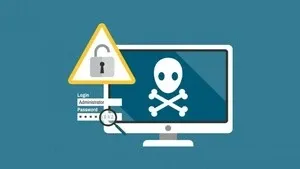This plan includes
- Limited free courses access
- Play & Pause Course Videos
- Video Recorded Lectures
- Learn on Mobile/PC/Tablet
- Quizzes and Real Projects
- Lifetime Course Certificate
- Email & Chat Support
What you'll learn?
- Cyber security
- Complete CEH v10
- Ethical hacking
- Hacking
Course Overview
This Course has 95 Lessons to cover complete training with theory as well as practical demonstrations. It covers syllabus of CEH v10 Certified Ethical Hacker version 10. Course has been design in a way so that any beginners level to advance level of people in cyber security can easily understand and can be benefited. Tutor is having more than 10 yrs Experience of providing training world wide.
Part 1: CEH Introduction
Part 2: Getting Ready with Windows PC for CEH
Part 3: Installing and Updating Kali Linux
Part 4: Hacking, Hacker Types and Ethics
Part 5: Hacking Vocabulary
Part 6: Information Security
Part 7: Attack Types and Vector
Part 8: 5 Phases of Hacking
Part 9: Foot Printing and Reconnaissance
Part 10: Google Hacking
Part 11: Website Reconnaissance
Part 12: Metagoofil Metadata
Part 13: Email Recon Footprint
Part 14: whois, nslookup tool for Recon
Part 15: Scanning Network
Part 16: Port Discovery
Part 17: Stealth Idle Scan
Part 18: OS & Application Fingerprint
Part 19: Vulnerability Scanning
Part 20: Windows Vulnerability
Part 21: Network Mapping Tool
Part 22: Proxy Server
Part 23: Public Proxy Server
Part 24: Enumeration Concept
Part 25: NetBIOS Enumeration
Part 26: SNMP Enumeration
Part 27: LDAP Enumeration
Part 28: SMTP Enumeration
Part 29: System Hacking Overview
Part 30: Windows Password Break
Part 31: Password Cracking Overview
Part 32: Password Cracking Telnet/HTTP/FTP
Part 33: Rainbow crack Lab Setup
Part 34: Rainbow Crack Demonstration
Part 35: Password Reset Hacking
Part 36: DHCP Starvation Attack
Part 37: Malicious Exe Script
Part 38: Spyware
Part 39: NTFS Alt Data Streams Exploits
Part 40: Steganography with Open puff
Part 41: Steganography with snow
Part 42: Covering track after hack
Part 43: Malware Overview
Part 44: Trojan Overview and Execute
Part 45: Creating Trojan
Part 46: Virus Overview
Part 47: Creating Virus
Part 48: Detecting Malware
Part 49: Malware Analysis
Part 50: Hash file verification
Part 51: Sniffing Overview
Part 52: CAM Table overflow, Port Security
Part 53: DHCP Snooping
Part 54: Dynamic ARP Inspection
Part 55: Social Engineering
Part 56: Denial of Service Attack
Part 57: Session Hijack
Part 58: Hack Web Server
Part 59: Buffer Overflow Attack
Part 60: Shell Shock Attack
Part 61: OWASP Broken Web Application Project
Part 62: SQL Introduction
Part 63: SQL Injection
Part 64: Web App Vulnerabilities Word press
Part 65: Wireless Hacking
Part 66: Using an Android VM
Part 67: Malware for Mobile
Part 68: Mobile Device Risk and Best practices
Part 69: Firewall Evasion
Part 70: Firewall ACL Example
Part 71: NAT and PAT Fundamentals
Part 72: IDS IPS Evasion
Part 73: Honeypot
Part 74: Cloud Computing
Part 75: CIA
Part 76: Policies
Part 77: Quantifying Risk
Part 78: Separation of Duties
Part 79: Symmetrical Encryption Concept
Part 80: Asymmetrical Encryption Concept
Part 81: Control Types
Part 82: Multifactor Authentication
Part 83: Centralized identity Management
Part 84: Kerberos and Single sign on
Part 85: Backup and Media Management
Part 86: Operation Security Control
Part 87: Physical Security Controls
Part 88: Incident Response
Part 89: VPNs
Part 90: Disaster Recovery Planning
Part 91: Pen Testing Tips
Part 92: Useful Tools
Part 93: Case Study
Part 94: IOT
Pre-requisites
- Networking Fundamental
- Computer Fundamantal
Target Audience
- Security professional
- Beginner hacker
- Security Experts
Curriculum 95 Lectures 32:03:40
Section 1 : Video Tutorial
- Lecture 2 :
- Part 1: CEH Introduction
- Lecture 3 :
- Part 2: Getting Ready with Windows pc for CEH
- Lecture 4 :
- Part 3: Installing and Updating Kali Linux
- Lecture 5 :
- Part 4: Hacking, Hacker Types and Ethics
- Lecture 6 :
- Part 5: Hacking Vocabulary
- Lecture 7 :
- Part 6: Information Security
- Lecture 8 :
- Part 7: Attack Types and Vector
- Lecture 9 :
- Part 8: 5 Phases of Hacking
- Lecture 10 :
- Part 9: Foot Printing and Reconnaissance
- Lecture 11 :
- Part 10: Google Hacking
- Lecture 12 :
- Part 11: Website Reconnaissance
- Lecture 13 :
- Part 12: Metagoofil Metadata
- Lecture 14 :
- Part 13: Email Recon Footprint
- Lecture 15 :
- Part 14: whois, nslookup tool for Recon
- Lecture 16 :
- Part 15: Scanning Network
- Lecture 17 :
- Part 16: Port Discovery
- Lecture 18 :
- Part 17: Stealth Idle Scan
- Lecture 19 :
- Part 18: OS & Application Fingerprint
- Lecture 20 :
- Part 19: Vulnerability Scanning
- Lecture 21 :
- Part 20: Windows Vulnerability
- Lecture 22 :
- Part 21: Network Mapping Tool
- Lecture 23 :
- Part 22: Proxy Server
- Lecture 24 :
- Part 23: Public Proxy Server
- Lecture 25 :
- Part 24: Enumeration Concept
- Lecture 26 :
- Part 25: NetBIOS Enumeration
- Lecture 27 :
- Part 26: SNMP Enumeration
- Lecture 28 :
- Part 27: LDAP Enumeration
- Lecture 29 :
- Part 28: SMTP Enumeration
- Lecture 30 :
- Part 29: System Hacking Overview
- Lecture 31 :
- Part 30: Windows Password Break
- Lecture 32 :
- Part 31: Password Cracking Overview
- Lecture 33 :
- Part 32: Password Cracking Telnet/HTTP/FTP
- Lecture 34 :
- Part 33: Rainbow crack Lab Setup
- Lecture 35 :
- Part 34: Rainbow Crack Demonstration
- Lecture 36 :
- Part 35: Password Reset Hacking
- Lecture 37 :
- Part 36: DHCP Starvation Attack
- Lecture 38 :
- Part 37: Malicious Exe Script
- Lecture 39 :
- Part 38: Spyware
- Lecture 40 :
- Part 39: NTFS Alt Data Streams Exploits
- Lecture 41 :
- Part 40: Steganography with Open puff
- Lecture 42 :
- Part 41: Steganography with snow
- Lecture 43 :
- Part 42: Covering track after hack
- Lecture 44 :
- Part 43: Malware Overview
- Lecture 45 :
- Part 44: Trojan Overview and Execute
- Lecture 46 :
- Part 45: Creating Trojan
- Lecture 47 :
- Part 46: Virus Overview
- Lecture 48 :
- Part 47: Creating Virus
- Lecture 49 :
- Part 48: Detecting Malware
- Lecture 50 :
- Part 49: Malware Analysis
- Lecture 51 :
- Part 50: Hash file verification
- Lecture 52 :
- Part 51: Sniffing Overview
- Lecture 53 :
- Part 52: CAM Table overflow, Port Security
- Lecture 54 :
- Part 53: DHCP Snooping
- Lecture 55 :
- Part 54: Dynamic ARP Inspection
- Lecture 56 :
- Part 55: Social Engineering
- Lecture 57 :
- Part 56: Denial of Service Attack
- Lecture 58 :
- Part 57: Session Hijack
- Lecture 59 :
- Part 58: Hack Web Server
- Lecture 60 :
- Part 59: Buffer Overflow Attack
- Lecture 61 :
- Part 60: Shell Shock Attack
- Lecture 62 :
- Part 61: OWASP Broken Web Application Project
- Lecture 63 :
- Part 62: SQL Introduction
- Lecture 64 :
- Part 63: SQL Injection
- Lecture 65 :
- Part 64: Web App Vulnerabilities Word press
- Lecture 66 :
- Part 65: Wireless Hacking
- Lecture 67 :
- Part 66: Using an Android VM
- Lecture 68 :
- Part 67: Malware for Mobile
- Lecture 69 :
- Part 68: Mobile Device Risk and Best practices
- Lecture 70 :
- Part 69: Firewall Evasion
- Lecture 71 :
- Part 70: Firewall ACL Example
- Lecture 72 :
- Part 71: NAT and PAT Fundamentals
- Lecture 73 :
- Part 72: IDS IPS Evasion
- Lecture 74 :
- Part 73: Honeypot
- Lecture 75 :
- Part 74: Cloud Computing
- Lecture 76 :
- Part 75: CIA
- Lecture 77 :
- Part 76: Policies
- Lecture 78 :
- Part 77: Quantifying Risk
- Lecture 79 :
- Part 78: Separation of Duties
- Lecture 80 :
- Part 79: Symmetrical Encryption Concept
- Lecture 81 :
- Part 80: Asymmetrical Encryption Concept
- Lecture 82 :
- Part 81: Control Types
- Lecture 83 :
- Part 82: Multifactor Authentication
- Lecture 84 :
- Part 83: Centralized identity Management
- Lecture 85 :
- Part 84: Kerberos and Single sign on
- Lecture 86 :
- Part 85: Backup and Media Management
- Lecture 87 :
- Part 86: Operation Security Control
- Lecture 88 :
- Part 87: Physical Security Controls
- Lecture 89 :
- Part 88: Incident Response
- Lecture 90 :
- Part 89: VPNs
- Lecture 91 :
- Part 90: Disaster Recovery Planning
- Lecture 92 :
- Part 91: Pen Testing Tips
- Lecture 93 :
- Part 92: Useful Tools
- Lecture 94 :
- Part 93: Case Study
- Lecture 95 :
- Part 94: IOT
Our learners work at
Frequently Asked Questions
How do i access the course after purchase?
It's simple. When you sign up, you'll immediately have unlimited viewing of thousands of expert courses, paths to guide your learning, tools to measure your skills and hands-on resources like exercise files. There’s no limit on what you can learn and you can cancel at any time.Are these video based online self-learning courses?
Yes. All of the courses comes with online video based lectures created by certified instructors. Instructors have crafted these courses with a blend of high quality interactive videos, lectures, quizzes & real world projects to give you an indepth knowledge about the topic.Can i play & pause the course as per my convenience?
Yes absolutely & thats one of the advantage of self-paced courses. You can anytime pause or resume the course & come back & forth from one lecture to another lecture, play the videos mulitple times & so on.How do i contact the instructor for any doubts or questions?
Most of these courses have general questions & answers already covered within the course lectures. However, if you need any further help from the instructor, you can use the inbuilt Chat with Instructor option to send a message to an instructor & they will reply you within 24 hours. You can ask as many questions as you want.Do i need a pc to access the course or can i do it on mobile & tablet as well?
Brilliant question? Isn't it? You can access the courses on any device like PC, Mobile, Tablet & even on a smart tv. For mobile & a tablet you can download the Learnfly android or an iOS app. If mobile app is not available in your country, you can access the course directly by visting our website, its fully mobile friendly.Do i get any certificate for the courses?
Yes. Once you complete any course on our platform along with provided assessments by the instructor, you will be eligble to get certificate of course completion.
For how long can i access my course on the platform?
You require an active subscription to access courses on our platform. If your subscription is active, you can access any course on our platform with no restrictions.Is there any free trial?
Currently, we do not offer any free trial.Can i cancel anytime?
Yes, you can cancel your subscription at any time. Your subscription will auto-renew until you cancel, but why would you want to?
Instructor

81282 Course Views
1 Courses



 Tech & IT
Tech & IT
 Business
Business
 Coding & Developer
Coding & Developer
 Finance & Accounting
Finance & Accounting
 Academics
Academics
 Office Applications
Office Applications
 Art & Design
Art & Design
 Marketing
Marketing
 Health & Wellness
Health & Wellness
 Sounds & Music
Sounds & Music
 Lifestyle
Lifestyle
 Photography
Photography

















